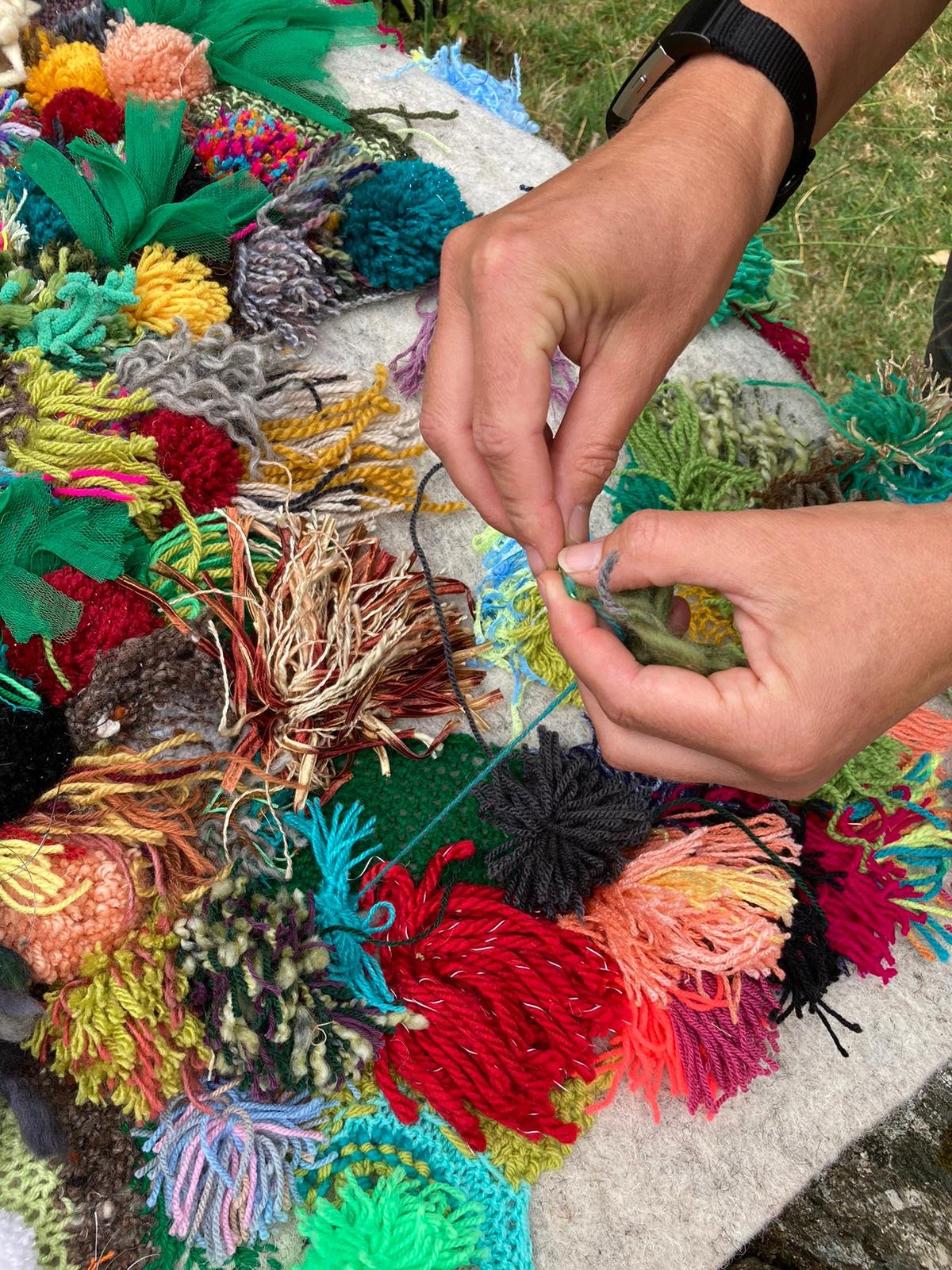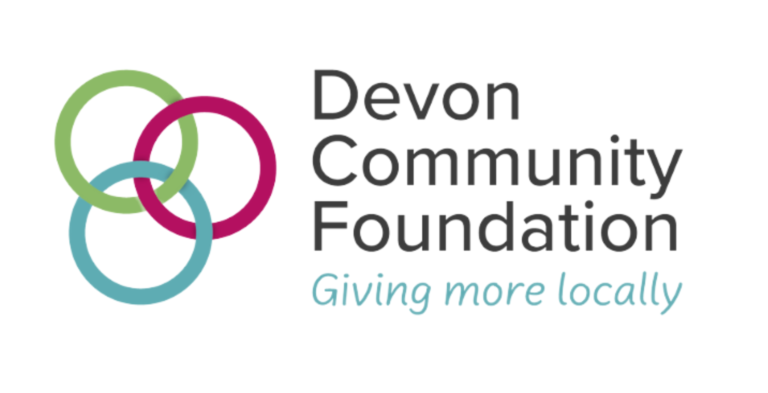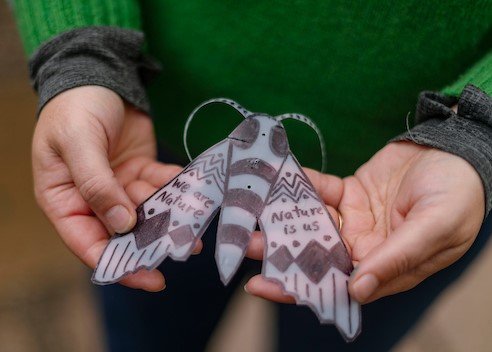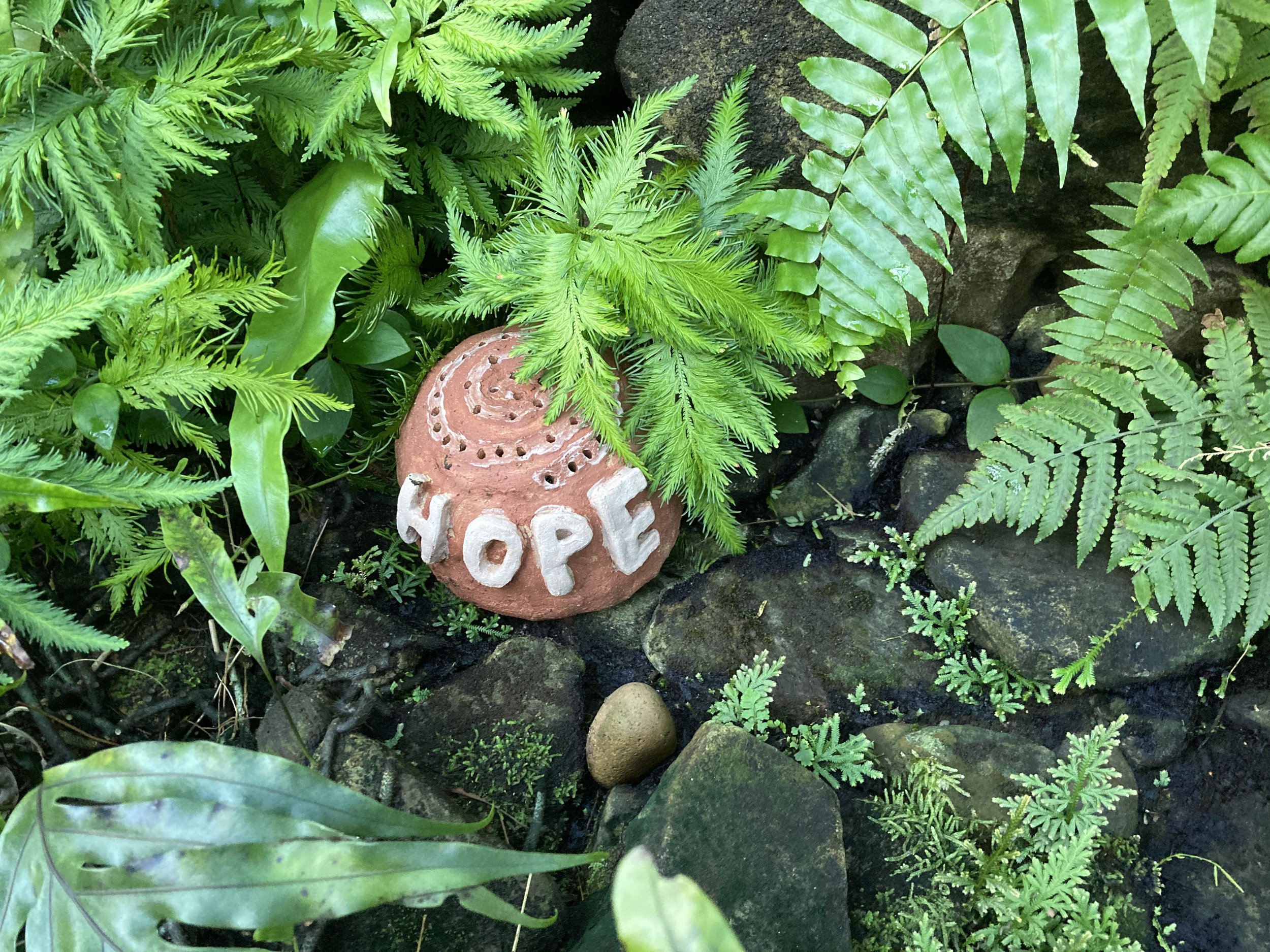The Mossy Carpet – From COP26 to COP30
There are moments in time where it’s worth reflecting on the development of an artwork.
Often times, you only ever see the end of an artworks journey, the moment that it is displayed in a public space. When the creative journey is over and only some statement of success is shared.
Participatory art is different. The work isn’t complete when people encounter it. There is an invitation to join in and the work is made fuller and deeper by each person that gets involved.
Our last mass-participation artwork ‘Moths to a Flame’ involved over 58,000 people. We looked to moths for inspiration, to help us understand our relationship with energy and power systems and the devastating affect this has on biodiversity and all of nature.
The artwork, thousands of hand strung moths made by many hands filled the Kibble Palace in Glasgow’s Botanic Gardens during COP26 and the space rang with the voices of people speaking to power and asking for commitments to change.
Moths to a Flame was an epic feat, not just because of Covid. It took all our time and attention for two years. It was a leap into the uncertain and there was a significant chance that the whole thing could have been a disaster. We didn’t have a signed agreement that we could even go ahead with the exhibition until the week before and even during COP and threats of strike action meant that the whole thing was at risk of never opening.
Holding that risk, being with the uncertainty, and continuing anyway, seems to be one of the lessons that comes with being prepared to respond to the climate emergency. We felt we had to act, despite the possibility of failure.
What we didn’t do though, was to decide what artwork would come next. We had a precipice at the end of the project. We were learning stuff about the world, stuff about the way we want to make work and stuff about what helped participants. We trusted that we would learn something from the experience and that we would cobble together a plan for what next as we went.
The dominant talk from delegates, visitors, ministers at COP that we spoke to was about carbon. Carbon emissions, Carbon calculations, carbon trading, carbon sequestration etc. It all felt intangible and unreachable for the average person. Despite working in sustainability for a very long time, even those of us who understood the meaning of the word found it hard to grasp at the reality of it.
As we pondered the failure of COP26 to progress real change, and as we wondered at the use of trying to ‘speak to power’ and dealing with the enormity of the climate and ecological emergencies, we began to notice the mosses.
The Kibble Palace and other spaces in Glasgow’s Botanic Gardens have some amazing mosses. You might overlook them because there are so many exceptional and magnificent specimens from all over the world, but the mosses have an epic story to tell. One of tiny actions making a huge difference. A story of nurture and protection powered by the sun’s energy. Theirs is the story of the creation of fossil fuels over eons, the slowing of water to prevent flooding, the purification of squalid air. Mosses, like the soft furnishings of the wild world show us about how to thrive through simplicity ad in the gaps between things, how to bring abundance back to abandoned places.
Did you know that mosses – especially those on our moorlands and wetlands, are some of the most important spaces in the world for capturing carbon underground? I hadn’t understood before now that our peatlands capture more carbon that rainforests!
Wouldn’t it be great if we could all #BeMoreMoss.
We recognise that huge swathes of us experience eco-anxiety in some form and this can make it hard to act, to decide what to do and how to do it. And we know that people feel hopeless and disconnected. So rather than create an artwork that exacerbates these feelings, we knew our next participatory artwork should speak to the power within and support participants to be more resilient.
The learning from Moths to a Flame resulted in a creative development framework called Our Compass – I guess to you could say it is something like a manifesto. It allows us to make sure we consider all the aspects of what we think it takes to make art during this time.
When we design an artwork, we think first about supporting participants to connect to and draw inspiration from the natural world, and then we think about how we can make something poetic that allows as many people as possible to get involved in being creative and discover steps that they can continue with in their own lives.
The Mossy Carpet has been designed to celebrate the tiny things we all do for a brighter greener future. It will be a visual and auditory feast, nurturing new ideas, celebrating action and connection and marking this important moment in our history. We want there to be a route to a brighter greener future, and maybe, this carpet which we hope will be 100 meters long by COP30 (Brazil) will help us to take steps towards that utopia.
The exciting thing about making an artwork that involves many people means that you have an opportunity to connect with a huge variety of perspectives. This September we have been supported by Devon Community Foundation and the British Science Festival to bring The Mossy Carpet to around 1000 people in groups across Devon including the Diocese of Exeter and with this funding, the carpet is now over 12 metres long!
Each session includes :
An introduction to mosses
A make with a chat about what people are doing in response to the climate and ecological challenge
We Tell the Tardigrade what we’re doing with tips and encouragement for anyone who wants to go on a journey to a sustainable future.
The Mossy Carpet will be displayed at Theatre Royal Plymouth throughout November and also at the Wild About Devon Awards in December! Please look at our events page for further details.
We look forward to working with all sorts of groups over the next few years. It’s our aim to involve over 100,000 people and to make something really rich, vibrant and supportive all with materials that would have been wasted.
We would love to collaborate with you and your group. We hope you will support this project as it grows and take time to consider how you might #BeMoreMoss.
The Mossy Carpet on display on Dartmoor, summer 2023
Thanks to the British Science Festival we were able to deliver three workshops with the Diocese of Exeter and look forward to continuing to explore mosses and spirituality together.
Thanks to Devon Community Foundation, we were able to bring The Mossy Carpet to St Levan’s Park Fun day, the MVV Energy from Waste fun day, Buckfast Abbey Summer Fair, Nature on The Green Fair in Newton Abbot, Heavitree Fun Day, Devon Open Studios in Exeter for two days, Crediton’s Sustainability Fair and workshop for National Trust volunteers at Lydford Gorge.
Art and Energy, summer 2021
Emerald moth - one of 2,500 species of moth in the UK and our inspiration for ‘Moths to a Flame’
Just one of the thousands of beautiful moths made with recycled milk bottle plastic and sent to us for display at COP26
Art and Energy’s award winning ‘Moths to a Flame’ artwork at Glasgow’s Botanic Gardens in 2021.
Our ceramic artworks amongst the mosses and ferns in the Kibble Palace
Exploring the world of mosses from the pavements outside our houses to the high moorlands of Dartmoor and beyond
Workshop at the Diocese of Exeter for the British Science Festival
Families at Heavitree Fun day making The Mossy Carpet with support from Devon Community Foundation
Making The Mossy Carpet at Crediton Sustainability Fair in Sept 2023 with support from Devon Community Foundation
Hands on creativity with The Mossy Carpet at day one of our Devon Open Studios events with support from Devon Community Foundation
Hands on creativity with The Mossy Carpet at day two of our Devon Open Studios events with support from Devon Community Foundation
The Mossy Carpet at St Levan fun day thanks to support from Devon Community Foundation
Engaging with The Mossy Carpet at MVV Energy from Waste fun day and Buckfast Abbey summer fair thanks to Devon Community Foundation
Devon Community Foundation supported a workshop with the National Trust’s Dartmoor area volunteers at Lydford Gorge





















